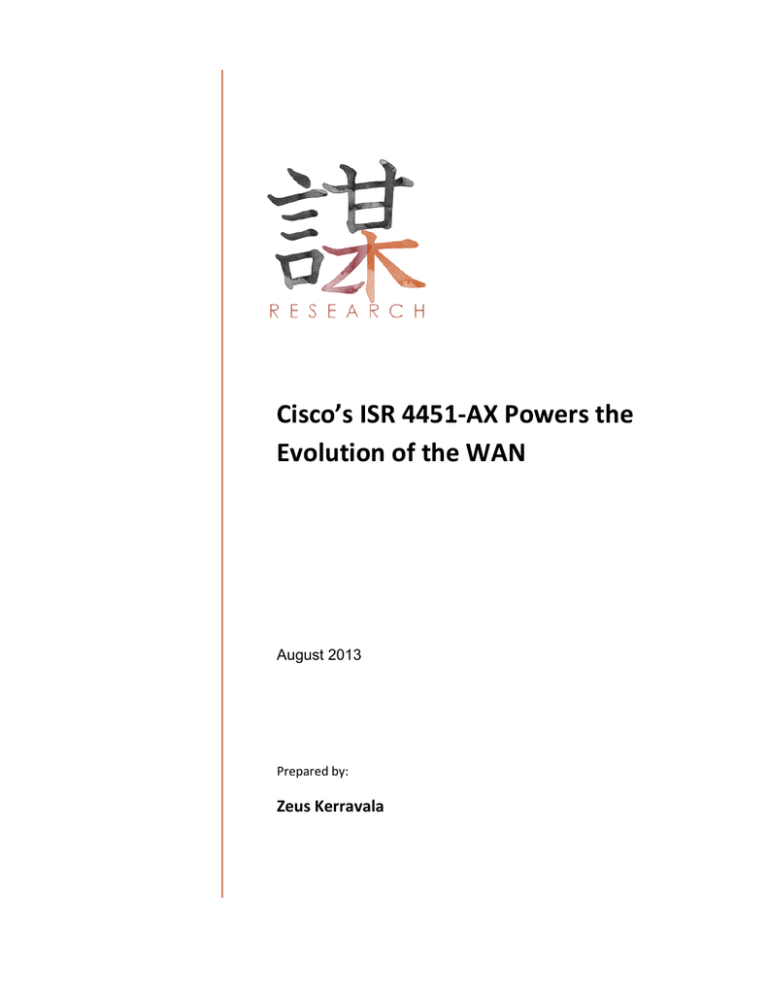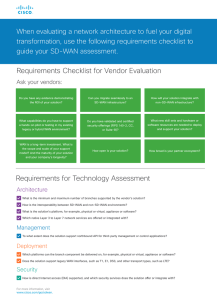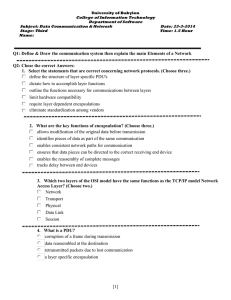
Cisco’s ISR 4451-AX Powers the
Evolution of the WAN
August 2013
Prepared by:
Zeus Kerravala
Cisco’s ISR 4451-AX Powers the Evolution of the WAN
by Zeus Kerravala
August 2013
ººº ºº ºº ººº ºº ºº ºº ºº ºº ººº ººº ºº ºº ººº ºº ºº ºº ºº ºº ººº ººº ºº ºº ººº ºº ºº ºº ºº ºº º
Introduction: The Time for WAN Evolution is Now
IT has gone through a significant evolution over the past decade. Virtualization
has changed the entire face of the data center, the network edge has become
predominantly wireless and consumer devices reign supreme. However, one of
the few areas of IT that has yet to evolve is the corporate wide area network
(WAN). Managing the WAN is something network managers have always
struggled with, since WAN speeds are typically an order of magnitude, or more,
lower than local area networks (LANs).
Historically, while not ideal, WANs met the needs of the enterprise as many
mission-critical applications were deployed locally, and WAN-based applications
were best-effort in nature. Today, the model has changed. Companies are
adopting network-centric compute models such as cloud (Exhibit 1) and mobile
computing, which raises the value and importance of the corporate WAN. In
addition, the significant rise in video, VoIP and virtual desktop traffic drives the
need to evolve.
ZK Research
A Division of Kerravala
Consulting
zeus@zkresearch.com
Cell: 301-775-7447
Office: 978-252-5314
Exhibit 1: Global Software-as-a-Service Forecast
Influence and insight
through social media
Source: ZK Research, 2013
As application performance becomes more dependent on the network,
application delivery requires IT to be more network-centric. For this to happen,
the network must shift from a tactical resource to a strategic asset that will play a
key role in IT success. However, for the WAN to achieve this level of strategic
importance, it must evolve.
© 2013 ZK Research
Influence and insight through social media
Section II: Limitations of Legacy WANs
The current WAN architecture was implemented a
decade or so ago for delivery of client/server
computing and best-effort Internet traffic. Cloud and
mobile computing are the fastest growing application
segments today and drive significantly different
traffic patterns than the legacy (LAN-based
client/server) compute model. WANs have the
following limitations:
•
Inefficient use of network bandwidth:
Business WANs are typically designed with a
hub-and-spoke architecture. Each branch is
connected only to the central hub for
connectivity. All traffic is sent over the WAN,
through a central location and then to its
destination, whether it’s the Internet or another
branch location. This trombone effect is highly
inefficient, as all traffic must pass through a
single choke point.
Exhibit 2: The Trombone Effect of WAN Traffic
Source: ZK Research, 2013
•
Lack of application visibility and control:
Improving user experience and application
performance has been a challenge for network
managers responsible for WANs. A high level
of visibility into the network enables network
managers to better understand how
applications perform. Based on visibility,
applications can be controlled in various ways
depending on criticality to the business.
•
Complexity of infrastructure: Branch offices
require many technologies to be a secure part
of the corporate network. This includes routers,
WAN optimization devices and servers. These
are often deployed using multiple platforms,
creating a highly complex environment.
•
Security deployed as an overlay technology:
With legacy networks, securing the network
was accomplished by deploying security tools
as an overlay to network technologies. This
makes it difficult to keep security policies
aligned with network policies.
Challenges associated with legacy networks are
significant today, as companies look to migrate their
IT strategies. It’s critical that CIOs and other IT
leaders make evolving the WAN a top priority.
“Leveraging the cloud was one of
the critical initiatives for our
company’s five-year IT vision. We
will move aggressively to the
cloud to get a leg up on our
competition.”
– CIO, Nationwide Retailer
© 2013 ZK Research
Influence and insight through social media
Section III: It’s Time to Evolve the WAN
“Shifting IT control points to the
network is the only scalable way
we can migrate our applications
to the cloud without putting the
business at risk.”
– CIO, Mid-Atlantic Based
Financial Services Firm
IT trends drive WAN evolution. The network needs
the same level of attention as compute or application
resources. However, the future is not yet clear.
Below are key points to consider when architecting a
WAN — for today and the next decade.
•
Optimize for cloud and mobile computing:
Legacy WAN thinking must be shed to support
the needs of an increasingly consumerized,
cloud-driven and mobile business. Hub-andspoke architecture must give way to greater
meshing and local Internet access.
•
Integrate security into the network: WAN
optimized for future applications must protect
the enterprise in new ways and at multiple
points. Security must be integrated with the
network to provide maximum protection.
•
•
Pervasive visibility: A key to optimizing user
experience is understanding how the network
impacts applications. Network managers must
have more visibility to set thresholds, find
bottlenecks and prioritize applications.
Application-aware networks: To optimize
application performance, the network must
recognize certain types of applications and
apply the right optimization techniques. This
ensures all users a consistent experience.
•
•
Application platform: The network must
provide capability for applications to be more
network-aware. The network must be an
application platform, and tightly couple
applications to the network. The ability to
deploy applications anywhere in the network
without compromising performance and
security will increase agility.
Rapid provisioning of applications and
network services: The business environment
continues to get more competitive. Gaining an
edge means being able to deploy applications
and services across the network faster. The
network must be an enabler of rapid
provisioning, instead of an inhibitor.
•
Optimize user experience and mobility:
Fulfilling the vision of cloud and mobile
computing is imperative. In fact, a 2013 ZK
Research study shows (Exhibit 3) improving
application performance is the top concern of
network managers. The infrastructure that
powers the network must evolve.
Exhibit 3: Top Priorities for Network Managers
Source: ZK Research, 2013
© 2013 ZK Research
Influence and insight through social media
Section IV: Cisco ISR 4451-AX: Purpose
Built for WAN Infrastructure
Branch offices and the WAN are in a state of
transformation. Network managers must strike a
balance between maintaining the status quo and
pushing forward with strategic IT projects. However,
the complexity of current infrastructure means
network managers spend almost all of their time
keeping the lights on. To help shift the balance to
the network as a strategic platform requires a new
approach to branch networks.
Cisco’s Integrated Services Router (ISR) elevates
the concept of the branch router. The ISR is a single
device that is easy to use and manage, which
provides customers with combined data, security,
UC and wireless services.
•
Faster time-to-market of network and
application services: The pay-as-you-grow
model means IT organizations can add new
network services quickly. IT departments can
respond to business requests immediately,
allowing real business agility.
•
Unmatched TCO: It’s common to see branch
offices with separate devices for security, WAN
optimization, routing, performance and other
branch functions. The ISR 4451-AX has all
branch services natively integrated and
optimized with hardware performance, for bestin-class performance across all services
(Exhibit 4). This offers TCO advantages
through hardware consolidation and operational
simplicity.
The ISR-AX branch routers takes the ISR concept
and adds higher-level (layer 4 to 7) services. It can
be thought of as a purpose-built network and
application platform that delivers an optimized user
experience. The ISR-AX combines traditional layer 2
and 3 services such as routing and security with
layer 4 to 7 application services for greater visibility,
control and WAN optimization.
This new ISR platform redefines branch routing and
WAN connectivity, and enables companies to
leverage mobile and cloud computing. The ISR
4451-AX is Cisco’s latest ISR-AX product and
combines high-performance branch routing with
scalable service delivery and simplified IT operations
in a 2-RU form factor. Despite the compact form
factor, it has leading-edge performance, with 2 Gigs
of forwarding performance. The ISR 4451-AX is a
leading network and security product but also brings
compute capabilities to the branch office, such as
servers and storage, with integration of Cisco UCS
E-Series Server blades. Companies that leverage
the ISR 4451-AX will realize the following benefits:
•
Pay-as-you-grow deployment model for
network services: The ISR 4451-AX has all of
its services natively integrated on the platform,
which can be enabled via a simple license key.
This means minimal downtime and disruption to
the business with no truck rolls. Unlike many
integrated platforms where an increase in
breadth-of-service means a decrease in
performance, the ISR-4451-X has separated
control, services and data planes and runs the
individual services in separate containers. This
separates and containerizes new services to be
provisioned without affecting the performance
of services already running.
© 2013 ZK Research
Influence and insight through social media
“Optimizing the performance of
our traditional, cloud and mobile
applications across our end-toend network has become one of
the most important tasks for
network operations. This has a
direct impact on user
productivity.”
– Head of Network Operations,
Global Law Firm
Exhibit 4: The ISR 4451-AX Offers Fully Integrated Services
Source: ZK Research, 2013
•
Consistent user experience: The ISR-4451-X
is loaded with natively integrated application
optimization features such as application
visibility and control (AVC) and WAN
optimization (WAAS) to ensure users have a
LAN-like experience even when accessing
applications over the WAN.
•
Optimization of real-time applications: The
new router’s features optimize performance of
real-time services such as VoIP and video. It
supports SIP, has an integrated session border
controller (SBC) and also provides voice-quality
management for benchmarking. Network
managers can provision intelligent paths as
well as QoS to ensure performance of real-time
services is not impacted by other traffic.
•
•
Integrated security: Network managers can
provision traditional network security features
such as IPsec VPNs, and application-level
security-like zone-based firewalls and cloud
Web security. An integrated, multifaceted
security is crucial in securing business
applications while increasing business agility.
Open, programmable network: Software
defined networks (SDNs) have dominated the
media during the past 24 months. However,
most organizations are unsure how to leverage
SDNs. The Cisco ISR 4451-AX goes well
beyond SDNs and brings a level of openness
and programmability to the network as a core
element of the Cisco Open Network.
Environment (ONE) and Cisco ONE Enterprise
Networks Architecture. Cisco has enabled a
rich set of open, programmable APIs with its
programming interface, onePK. This ultimately
leads to faster application and service
provisioning across the enterprise network.
•
Future proofs the WAN: With 2 GB of
performance and native services, companies
can leverage the ISR 4451-AX platform today
and keep it in place for the foreseeable future.
The product offers outstanding value as an
enabler of WAN services, and also provides
investment protection, as it will not need to be
replaced for future services.
Legacy infrastructure often means network
managers must compromise one or more important
elements, such as cost, performance, security or
manageability. Given rapidly changing business and
network environments, it’s critical IT leaders choose
a platform where the services can scale with the
business and still offers state-of-the-art security that
is affordable and manageable. The ISR 4451-AX is
the right platform to enable companies to harness
business opportunities today, with a branch router
that delivers the functionality to meet IT challenges
today and into the future.
© 2013 ZK Research
Influence and insight through social media
Section V: Conclusion and
Recommendations
The nature of work is changing, and organizations
want to leverage the flexibility and power of mobile
and cloud computing. While these compute models
are very powerful, they are the most network-centric
compute paradigms to date. The corporate network
can no longer be thought of as a tactical resource or
cost center. Business leaders, CIOs and IT leaders
should consider the network a strategic asset which
will play a significant role in enabling companies to
rapidly respond to the new business opportunities
and efficiencies of the cloud and mobile era.
•
Leverage the network for computing
success: Legacy network thinking needs to go.
Computing success is highly dependent on the
network. Business and IT leaders need to
consider the network when planning any kind of
IT initiative. Focusing on the WAN will create
the most secure and lowest-risk deployment
strategy for future applications and network
services.
However, to reach this level of strategic value, the
corporate WAN must evolve into an enabler of
application experience and network services. A
successful WAN evolution depends on the right
architecture, but also a next-generation network
platform capable of delivering all of the branch
services with uncompromised security and
performance. Cisco’s ISR 4451-AX is ideally suited
to meet the challenges of today and the future, and
should be considered as a building block for any
company looking to leverage the WAN for strategic
value. To successfully build a next-generation WAN,
ZK Research recommends the following:
•
Take an architectural approach to building
the WAN: A network is more than a collection
of routers and other devices. An architectural
approach ensures the network can not only
connect users to resources, but can also
ensure a high quality, optimized user
experience with a lower TCO than a
nonarchitectural approach. Cisco ONE and
Cisco ONE Enterprise Networks Architecture
enable enterprises to evolve the WAN with
minimal risk.
•
Invest in the network now: Any organization
even thinking about cloud and mobile
computing should invest in the network to
ensure the foundation is there to transition to
the enterprise — no matter what speed the
business wants to move forward. It’s critical
companies choose infrastructure than can
enable the proper level of network intelligence,
security and application intelligence to enable a
quality user experience, rather than using
network infrastructure that is simply good
enough. When it comes to the network, a good
enough network is no longer good enough.
© 2013 ZK Research: A Division of Kerravala Consulting
All rights reserved. Reproduction or redistribution in any form without the express prior permission of ZK Research is expressly prohibited.
For questions, comments or further information, email zeus@zkresearch.com.









